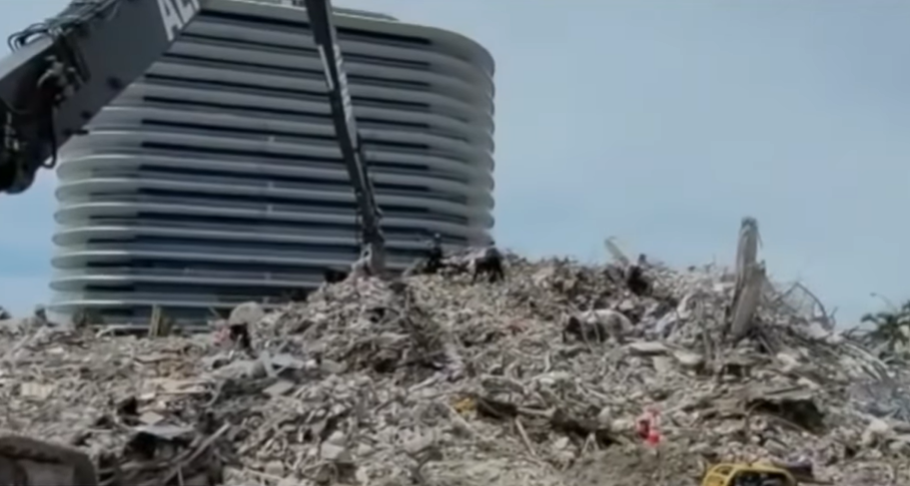This writer, born and raised on the West Coast of Florida, and who ended up, much to his surprise, practicing law in Miami for about 40 years before finally being able to escape to New Hampshire (where he had been visiting frequently over that 40 year period), has some thoughts about the tragic collapse of the high rise condominium building in Surfside, Florida.
Surfside is a small municipality on the barrier island that contains Miami Beach and several other smaller municipalities. It is North of Miami Beach proper and South of Bal Harbor, home of the famous ritzy Bal Harbor Shoppes.
When high rise buildings are constructed in many parts of the country, the basic framework of the buildings is often comprised of steel girders bolted or welded together. But in many parts of the country, including South Florida, high rise buildings are usually now constructed of poured concrete with reinforcing steel bars (“rebars”) within the concrete. It is faster and cheaper than using a steel skeleton.
Related: The Florida Building Collapse was Predictable
Many years ago, it was rumored that when developers built structures out of concrete on the shore of the Miami Beach barrier island, they supposedly used concrete mixed on site for much of the work and allegedly utilized beach sand in the concrete mix. Since the beach sand contained salt, it was claimed that this practice led to the early deterioration of reinforcing rebars and the concrete itself. Rumors or facts? No one really knows.
South Florida has adopted and supposedly enforces one of the strictest building codes in the country because of the recurrent exposure to hurricanes. But that has not always prevented problems, losses of property, and losses of life.
The applicable building codes require government-employed building inspectors to inspect and “pass” or “fail” virtually every step in the construction process, including inspecting the concrete forms, the rebars, and the concrete pours. All this is supposed to take place after the detailed building plans, including engineering drawings and any required engineering studies (such as, for example studies of wind resistance at different levels of a proposed high rise), have been prepared by licensed professionals and reviewed and approved by municipal gatekeepers.
All that being said, when the large and dangerous Hurricane Andrew hit South Florida in August of 1992, in at least one recently constructed large residential subdivision many roofs became detached from their homes in the wind and flew away like large kites because although they were supposed to have been tied down to the roof trusses and support members with “hurricane ties,” many of such ties were either missing or not properly installed. Yet they had supposedly been inspected and passed by local building inspectors. Once again, resort to rumors: in some situations, it has been claimed that building inspectors did “drive-by” inspections in which they merely drove by a project and signed off their approval rather than exiting their vehicles and climbing into the roof attic areas to determine if the roofs had been tied down properly. Fact or fiction?
One thing is fairly certain, the government is not held liable for damages caused by a failure of a building inspection, even if it causes property damages or loss of life. Why? Sovereign immunity- our concept inherited from English law based on the notion that the King can do no wrong. So, when damages are caused by the negligence of government officials, they and the government agency itself (such as, for example, the municipality) are almost always off the hook.
You may see in the press stories indicating that people damaged by the Surfside collapse, or who lost loved ones in the collapse, plan to sue everyone in sight including the town and/or the county- but at the end of the day, it is highly unlikely that claims against those government entities will be successful because of sovereign immunity.
Recent proposals in New Hampshire would roll back some aspects of sovereign immunity so that the government agencies that employ persons who cause damages to our citizens can be held liable- this would place a much-needed incentive on the employing government agencies to be very careful in recruitment, training, and supervision of its employees. Under the most recent proposals, the individual employee would not be held liable, or even be named in a suit for damages- only the employing government agency would be potentially liable, subject to the obligation of a claimant to prove their case for simple or willful negligence of the employee resulting in damages by the greater weight of the evidence. But these proposals have a long way to go before they might be adopted.
In the meantime, there is a certain irony in the comparison of construction licensing in Florida versus New Hampshire. In Florida, every general contractor must pass a test and be licensed, and there are actually numerous categories of specialized contractor licensing. In New Hampshire, there is no licensing required of contractors, general or otherwise. Electricians, plumbers, and gas fitters are required to be licensed- but contractors- No.
Occupational licensing proponents claim that its purpose is to protect the public, but in reality its true purpose is to protect those existing members of the licensed occupation from new competitors.
Since the proponents of strict licensing requirements for construction professionals claim that it those requirements are designed to protect the public against shoddy construction that might result in damages or loss of life (like in Surfside), when was the last time you heard of any building constructed in New Hampshire by an unlicensed contractor actually collapsed?
